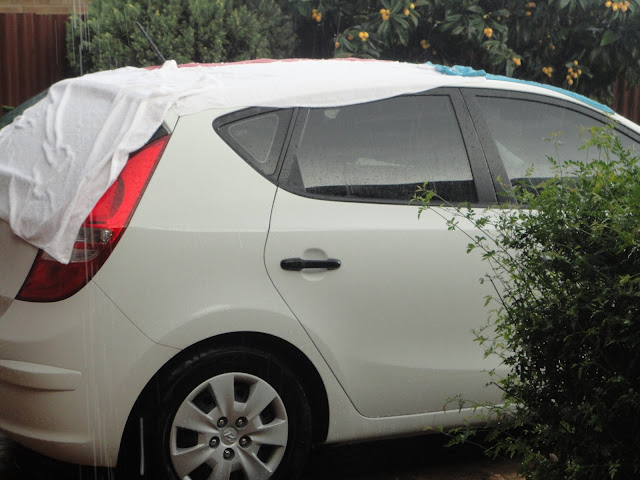On Saturday I made 4 litres of Lemon Cordial using lemon juice and a syrup made of 1 litre water to 1 kg sugar for every litre of juice. A lot of juicing, but worthwhile, natural and refreshing.
 |
| A nice glass of cordial with mint leaves |
Then after a bit of preparation I finally made the soap from Rhonda´s recipe. It was easier than I had anticipated and today I have already taken them out of their silicon moulds and they will now dry for 6 weeks until they are ready to use.
Here is the recipe :
450ml rain water, or distilled water. (If using tap water let stand for 24 hours before using)
172gr caustic soda/lye
1litre olive oil (a cheap one will do)
250gr copha (vegetable fat made from hydrogenated coconut oil),found in the butter section or coconut oil.
Materials needed :
Measuring jug
Stainless steel pot (do not use aluminium pots)
Stainless steel, plastic or wooden spoon
Kitchen thermometer
Scale
Mixer or electric blender
Moulds
Preparation:
- Measure all ingredients beforehand.
- Work in a well ventilated area, as when you mix the caustic soda with water, the mix can burn you or the the bench tops, and it emits fumes.
- Make sure there are no children or pets around when you are working with the caustic soda.
PS: Animal or vegetable fats can be used to make soap. All soaps are made using caustic soda, but when they go through the chemical process (saponification) all ingredients come together over the course of a few weeks and the caustic soda is neutralised making the soap safe to use. Home made soap contains natural glycerin unlike the commercial soaps where it is extracted and other chemicals are added to counteract this, and the glycerin is then sold as an expensive product.
4 - Using the thermometer check the temperatures of both the oil and the caustic soda and
when both reach 50ºC you can mix them, pouring the oil into a mixing bowl first, then the caustic soda.
when both reach 50ºC you can mix them, pouring the oil into a mixing bowl first, then the caustic soda.
 |
| The oils and caustic soda mix are now together |
 |
| The soap mix reaches trace
5 - Mix with a hand blender, I used my Kenwood mixer. Start in the lowest setting so the mix doesn´t splash, (I have a cover that fits over the bowl) and when it's thick increase the speed, until it reaches trace - that is when the soap thickens. If you drizzle soap it leaves traces that don´t disappear into the mix.
It could take about 10 minutes, but it all depends on different oils used.
If you want to use essential oils or essences you can add them at this stage.
I sometimes add oats.
|
 |
| The moulds are already oiled |
 |
| I used a soup ladle to pour into the moulds
6- You can use silicon moulds (used for cakes) or well washed milk cartons or plastic containers. (Again - use no aluminium) I used a soup ladle to help pour the mix into the moulds.
7 - Wrap the moulds with some towels or blankets to keep the mix warm.
8 - After about 15 hours unmould and cut into bars.
9 - Let dry for 6 weeks before using.
|
 |
| Ready to dry for 6 weeks |
Saponification - scientific explanation http://sci-toys.com/ingredients/soap.html
* * * * * * * * * * * * * * * * * * *
After the soap making session it was time to get dressed and ready to go to a Dinner/Dance at the Portuguese Social Club. The event was being held at the Stirling Bowling club.
The dinner was Beef Curry or Beef Stew, and both were very tasty.
The party theme was "Madeira
Island", but not many people were wearing the Madeira traditional dress, I don´t think it would be easy to find such an outfit in Perth. Entertainment was good, starting with various talented young singers and then the DJ carried on with dance music until the early hours of the morning. We had a big group of 20 people sitting at two tables and it was a very pleasant evening.
 |
| Hubby and I after a dance |
 |
| The hall before the party started |
 | ||
The traditional Madeira house - a miniature on stage
|
 |
| My car covered in bath towels |
 |
| The grass covered in hail balls |




You've had a busy weekend! I'm impressed!
ReplyDelete(PS I've tried to leave several comments on other posts but none of them have been published)
PiP :(
Hi Piglet, thanks for visiting.
ReplyDeleteThanks for the soap tutorial! I've bookmarked it for future use. In 8th grade, my mother and I made soap. We used aluminum (one of the big mistakes we made) and could not get it out. We left it upside down overnight and in the morning found the lye had dripped out and left a rectangle shaped etching on our oak table. We also put an entire bottle of rose oil in...needless to say, we never used it!
ReplyDeleteThanks for visiting Lovely Light - thank goodness for internet where we can learn all the ins and outs, do and don´ts. I am quite quite eager for them to cure for another 4 weeks so I can start using them.
ReplyDeleteSami, After I busy afternoon doing soaps, you still have gouts to dress up to go dinner and dance. Congratulations.
ReplyDelete